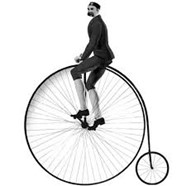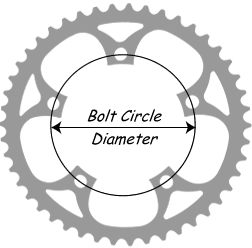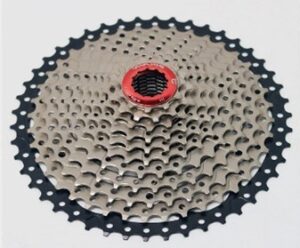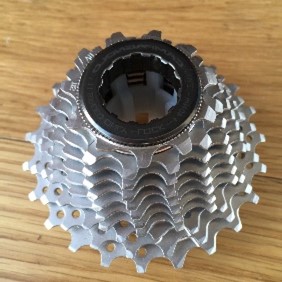Gearing Explained
Gear Ratio Lingo:
Gear Ratio impacts how far the bike travels for each rotation of the crank. A “high” gear travels farther each pedal stroke than does a “low” gear. And of course, the farther you push the bike each pedal stroke, the more force and energy it takes to turn the crank.
Most humanoids pedal most efficiently at around 80 – 100 rotations per minute. Multi-speed bicycle drivetrains allow riders to pedal in that sweet spot over a variety of speeds and terrain and with varying effort.
There are several terms to describe the gear ratio of different chainring and cog combinations.
The traditional “Gear Inches” is an archaic term that defines the diameter of an old-fashioned high wheeler’s wheel that has a diameter such that it would travel the same distance per pedal stroke. I find this term not very useful. A more contemporary term is “Development”, how far the bike travels with each rotation of the crank.

The lowest gear on a typical compact drive road drivetrain with an 11×28 cassette allows the bike to travel about 2.6 meters per crank revolution. That’s low enough for say Alpine hill, but not low enough for some of the conditions we occasionally encounter on dirt rides. The hills are steeper (20%+) and the soft ground has a higher rolling resistance, adding to the effort required.
Switching to a 32t large cassette drops the travel distance 12.5% to 2.3 meters with a corresponding 12.5% drop in effort.
A 34t large cassette drops it another 9% to 2.15m per revolution.
Mashing it up the hill in too high of a gear is not only painful, its inefficient; you will climb slower than if you had a gear that allowed you to keep a higher cadence. We recommend using a low gear with a gain of 2.3 meters per revolution or less for all-road riding. While a 28t or even a 26t large cassette cog is probably adequate for those asphalt only riders.
the highest gear on the same compact drivetrain allows the bike to travel 9.8 meters per crank revolution, 429% farther than in low gear. Pedaling at 100 rpm, you would be traveling at 36.5 MPH. Switching to a 52 t chainring would increase travel distance to 10.2 meters or 38 mph.
Cassettes
Cassettes come in a variety of gear ranges from 11-23t (a 209% gear Range) up to 10-50t (a 500% gear range). Cassettes with a higher gear range of around 400% + will be better suited for all-road riding with its varying terrain. A 11t-28t cassette has a 250% gear ration range that should prove adequate for most asphalt only road riding.
Derailleur capacity: manufactures list the maximum capacity of their derailleurs on their websites. The first criteria is the maximum chain uptake, that is the total number of teeth difference between the lowest and the highest gears. The formula for this is
(large chainring teeth+ large cassette teeth) – (smallest chainring teeth + smallest cassette teeth = uptake capacity. So, for example (50+28) – (34+11) = 33 teeth uptake.
They also list maximum cog size. The derailleur cannot get the pulleys far enough down to clear a cassette cog larger than this; the pulleys drag on the cassette.
Shimano makes their derailleurs on both a “long cage” and a “short cage” version. The Ultegra gs 6800 11 spd long cage rear derailleur has a 32t capacity. The newer Ultegra 8000 11 speed has a 34t capacity. Sram and Campy components are similar.
Road link hanger: If you find your derailleur can not handle a big enough cassette, one good trick is adding a Wolf Industries road link https://www.wolftoothcomponents.com/collections/drivetrain-1/products/roadlink . It simply lowers the derailleur about ¾”, allowing it to get below a big cog. We managed to run a 46t cassette with an Ultegra GS derailleur and one of these.

Cranksets
Compact Vs. Standard cranksets: Up until the late 1990s, most road cranksets had a 144mm or 130mm chainring bolt circle diameter.

The smallest inner chainring that would fit this spacing was around 39t. The outer chainring was typically 52 or 53 teeth. This may have been just the ticket for the Giro, but the gearing tended to be too tall for most noncompetitive riders. FSA introduced the first compact drive around 2002 and everyone else soon followed suit.
A compact crankset typically has a 50 t large ring and a 34t small ring. This gives both a 13% lower gear and a broader jump in ratio between the two chainrings. (thus, providing a wider overall gear ratio range) For road racing, where close rations are advantageous and showing off how buff you are is key, one may want to stick to a standard 52-39 crank. But for real life everyday riding, we find that a compact crank will perform better.
1×12 vs. 2×11 drivetrains: Drivetrains with a single chainring and no front derailleur are all the rage in Cyclo-cross and gravel bike circles these days. Almost all 2020 cx bikes come fitted with 1×12 drivetrains. In Cx racing, the front derailleur’s dropping the chain at inopportune times was a constant problem, one well solved by just eliminating it altogether. Sram, Shimano and now Campagnolo offer 1x drivetrains with 11, 12 or even 13 speed rear cassettes, some with as many as 50 t. As the following gear charts illustrate, a Sram 1×12 with a 10×42 cassette has a low gear development of 2.35meters and a 420% gearing range, more-or- less the same as a 2×11 set up with a 32t large cassette. So, the 1x set up does not compromise gear range or low gear. It just has slightly bigger jumps between each gear. This could be a disadvantage on a fast road ride when you want to shift frequently to maintain cadence. But it is not as much of an issue off road where cadence is less critical. And not having to fiddle with shifting both front and rear derailleur is a plus. Weather you choose a 1x or a 2x setup is a matter of personal preference; they will both perform well.
gear charts: here are gear ratio charts showing development for popular 2×11 and 1×12 gearing combinations.
| 2×11 drivetrain | |||||||
| (with standard compact 34×50 double chainrings) | |||||||
| development in meters | |||||||
| cassette | Chainring 34t | 50t | % change | ||||
| 11 | 6.65 | 9.77 | |||||
| 12 | 6.09 | 8.96 | 8.3% | ||||
| 13 | 5.62 | 8.27 | 7.7% | ||||
| 14 | 5.22 | 7.68 | 7.1% | ||||
| 15 | 4.87 | 7.17 | 6.7% | ||||
| 17 | 4.30 | 6.32 | 11.8% | ||||
| 19 | 3.85 | 5.66 | 10.5% | ||||
| 22 | 3.32 | 4.89 | 13.6% | ||||
| 25 | 2.92 | 4.30 | 12.0% | ||||
| 28 | 2.61 | 3.84 | 10.7% | ||||
| 32 | 2.28 | 3.36 | 12.5% | ||||
| total range | 427.8% | ||||||
| 1×12 drivetrain | 1×12 drivetrain | ||||||
| with a 46t chainring | with 48t chainring | ||||||
| development in meters | development in meters | ||||||
| cassette | % jump | cassette | % jump | ||||
| 10 | 9.89 | 10 | 10.32 | ||||
| 12 | 8.24 | 16.7% | 12 | 8.60 | 16.7% | ||
| 14 | 7.06 | 14.3% | 14 | 7.37 | 14.3% | ||
| 16 | 6.18 | 12.5% | 16 | 6.45 | 12.5% | ||
| 18 | 5.49 | 11.1% | 18 | 5.73 | 11.1% | ||
| 21 | 4.71 | 14.3% | 21 | 4.91 | 14.3% | ||
| 24 | 4.12 | 12.5% | 24 | 4.30 | 12.5% | ||
| 28 | 3.53 | 14.3% | 28 | 3.69 | 14.3% | ||
| 32 | 3.09 | 12.5% | 32 | 3.23 | 12.5% | ||
| 36 | 2.75 | 11.1% | 36 | 2.87 | 11.1% | ||
| 42 | 2.35 | 14.3% | 42 | 2.46 | 14.3% | ||
| total range | 420.0% | total range | 420.0% |

